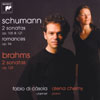Brahms; Schumann Clarinet Sonatas
A sensitive and sympathetic partnership shows Brahms in the best possible light
View record and artist detailsRecord and Artist Details
Composer or Director: Johannes Brahms, Robert Schumann
Genre:
Chamber
Label: Sony Classical
Magazine Review Date: 2/2007
Media Format: CD or Download
Media Runtime: 100
Mastering:
Stereo
DDD
Catalogue Number: 88697 00025-2

Tracks:
| Composition | Artist Credit |
|---|---|
| Sonata for Violin and Piano No. 1 |
Robert Schumann, Composer
Alena Cherny, Piano Fabio di Càsola, Clarinet Robert Schumann, Composer |
| Sonata for Violin and Piano No. 2 |
Robert Schumann, Composer
Alena Cherny, Piano Fabio di Càsola, Clarinet Robert Schumann, Composer |
| (3) Romanzen |
Robert Schumann, Composer
Alena Cherny, Piano Fabio di Càsola, Clarinet Robert Schumann, Composer |
| Sonata for Clarinet and Piano No. 1 |
Johannes Brahms, Composer
Alena Cherny, Piano Fabio di Càsola, Clarinet Johannes Brahms, Composer |
| Sonata for Clarinet and Piano No. 2 |
Johannes Brahms, Composer
Alena Cherny, Piano Fabio di Càsola, Clarinet Johannes Brahms, Composer |
Author: John Warrack
Fabio di Càsola has a fluency of line, a quick ear for detail and a feeling for Brahms’s long phrases that well suit the two clarinet sonatas, and in this he has a sensitive and sympathetic partner in Alena Cherny. Such an equal partnership is vital in these works. Brahms was a fine pianist, and though the piano parts are very fully scored, the balance is skilfully calculated. By this late stage of his career, he certainly knew what he was about and he also knew what he could expect from his admired clarinettist, Richard Mühlfeld. Di Càsola is not afraid to go for the invigorating Vivace finale of the First Sonata enthusiastically, as well as to give the Allegretto grazioso a gentle waltz lilt; there is ample warmth in the opening Allegro amabile of the Second Sonata.
The Schumann record in this double issue is not really of clarinet music. There are places where it shows: for instance, the violin chords opening the Second Sonata sound strained on the clarinet, and again in the third movement the arpeggiated pizzicato violin chords do not really work when transferred to a gentle stroking on the clarinet. But the finale goes easily and effectively, and so does the Allegretto of the First Sonata. There is not really a problem with the Op 94 Romances, originally for oboe but published in the first edition as optionally for violin or clarinet. They sound well on the clarinet, especially in these relaxed and pleasant performances.
The Schumann record in this double issue is not really of clarinet music. There are places where it shows: for instance, the violin chords opening the Second Sonata sound strained on the clarinet, and again in the third movement the arpeggiated pizzicato violin chords do not really work when transferred to a gentle stroking on the clarinet. But the finale goes easily and effectively, and so does the Allegretto of the First Sonata. There is not really a problem with the Op 94 Romances, originally for oboe but published in the first edition as optionally for violin or clarinet. They sound well on the clarinet, especially in these relaxed and pleasant performances.
Discover the world's largest classical music catalogue with Presto Music.

Gramophone Digital Club
- Digital Edition
- Digital Archive
- Reviews Database
- Full website access
From £8.75 / month
Subscribe
Gramophone Full Club
- Print Edition
- Digital Edition
- Digital Archive
- Reviews Database
- Full website access
From £11.00 / month
Subscribe
If you are a library, university or other organisation that would be interested in an institutional subscription to Gramophone please click here for further information.




